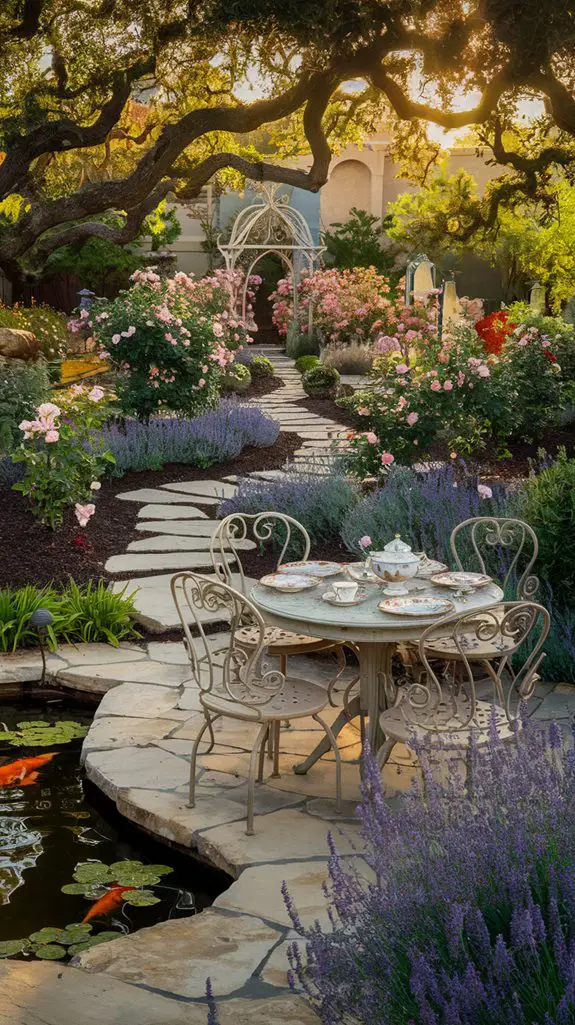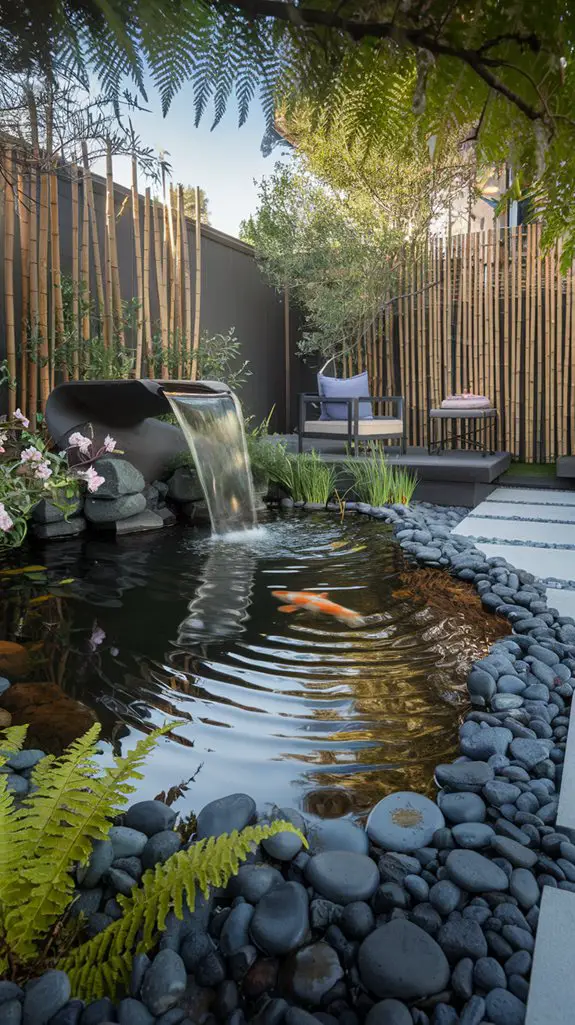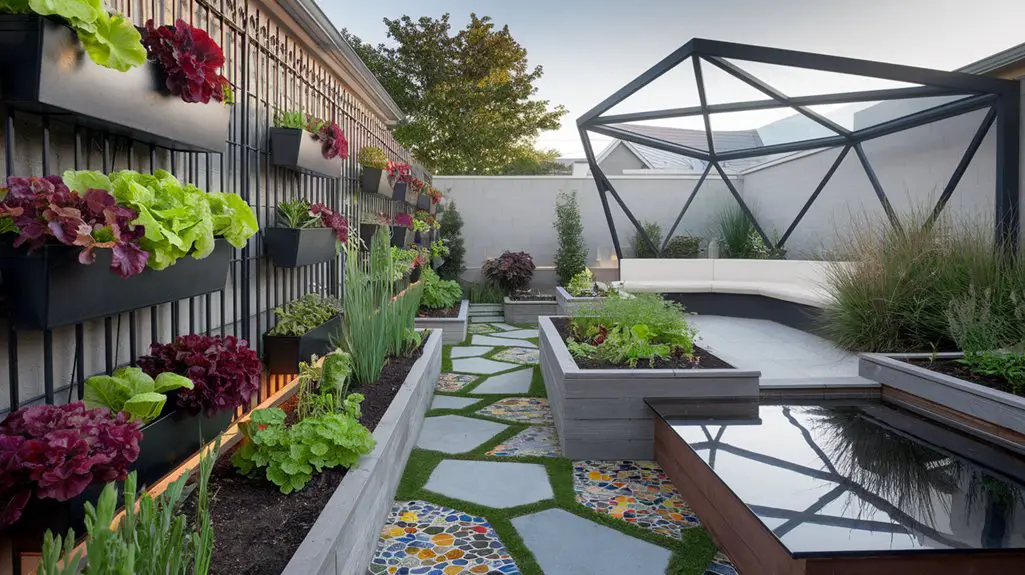When you think about backyard garden design, consider innovative approaches that elevate your space into a vibrant ecosystem. Vertical gardening can help you maximize limited areas, while edible landscapes combine beauty with functionality. Exploring themed garden spaces can reflect your personal style and support biodiversity. But what sustainable practices can you incorporate to guarantee your garden thrives harmoniously with the environment? Let's explore these ideas further.
Vertical Gardening: Maximizing Space With Greenery
As you explore the possibilities of vertical gardening, you'll discover how it transforms limited spaces into lush, green retreats. By utilizing walls, fences, and trellises, you can create a stunning vertical garden that maximizes your area while minimizing your footprint.
Choose a variety of plants suited for vertical growth, like climbing vines, wall planters, or tiered shelves. Incorporating sustainable practices, such as drip irrigation and organic fertilizers, guarantees your garden thrives without harming the environment. Adding creative vertical garden ideas can further inspire your designs and enhance the overall aesthetic.
You can also enhance biodiversity by attracting pollinators with colorful blooms. As you design your vertical garden, consider factors like sunlight, drainage, and accessibility to create a vibrant and functional space that reflects your style while promoting ecological balance.
Edible Landscapes: Growing Food and Beauty Together
While many gardeners focus on aesthetics, combining beauty with functionality can elevate your outdoor space to new heights. Edible landscapes harmonize vibrant plants with practical food production, creating a space that's both stunning and sustainable.
Start by selecting ornamental varieties of fruits, vegetables, and herbs—think purple basil or strawberry ground covers—that serve dual purposes. Layering plant heights encourages biodiversity, while interplanting flowers attracts pollinators, enhancing yields.
Utilize companion planting to maximize health and productivity, such as pairing tomatoes with basil. Incorporate pathways of natural materials for visual interest and ease of access. Additionally, consider building raised beds with recycled materials to enhance sustainability and reduce waste in your gardening practice.
Themed Garden Spaces: Creating Unique Experiences

Edible landscapes beautifully blend aesthetics and functionality, but themed garden spaces take this concept even further by immersing you in unique experiences.
Imagine a Mediterranean retreat with olive trees, lavender, and citrus, inviting you to unwind. Or consider a whimsical fairy garden, where miniature plants and charming decorations spark your imagination.
Each theme creates a distinct atmosphere, encouraging interaction and exploration. You can use color, texture, and even sound to enhance your design—think rustling grasses or gentle water features.
Incorporating native plants not only supports local wildlife but also complements your theme. Native plant landscaping can enhance biodiversity, ensuring a vibrant ecosystem. By carefully selecting plants and materials, you'll craft an engaging space that resonates with your personality and lifestyle, transforming your backyard into a personal sanctuary.
Sustainable Practices: Eco-Friendly Design Ideas
Embracing sustainable practices in your backyard garden not only benefits the environment but also enhances the overall design.
Start by using native plants, which require less water and attract local wildlife, promoting biodiversity. Incorporate recycled materials for pathways and borders; reclaimed wood or stones add character while reducing waste.
Implement a compost system to recycle kitchen scraps, enriching your soil naturally. Consider vertical gardening to maximize space and reduce the need for extensive land coverage. Eco-friendly vertical gardening can also help in optimizing air quality and providing fresh produce.
Utilize rainwater harvesting techniques, such as barrels, to irrigate your plants sustainably. Finally, embrace organic gardening methods to minimize chemical use, ensuring a healthier ecosystem.
With these eco-friendly design ideas, you'll cultivate a vibrant, sustainable garden that reflects your commitment to the planet.
Water Features: Enhancing Serenity and Atmosphere

Incorporating water features into your backyard garden creates a serene atmosphere that complements your eco-friendly design. You might consider options like a small pond, a bubbling fountain, or even a rain garden.
These features not only provide aesthetic value but also support local wildlife, attracting birds and beneficial insects. To enhance sustainability, use a recirculating pump for fountains and select native plants around ponds to minimize water usage.
Consider installing a rainwater harvesting system to keep your feature eco-friendly and reduce runoff. By integrating natural materials like stone or reclaimed wood, you can further harmonize your water feature with the landscape. Additionally, backyard water features can significantly improve the overall ambiance, making your garden feel more inviting.
Ultimately, these elements transform your garden into a tranquil retreat, promoting relaxation and connection with nature.
Outdoor Living Areas: Merging Nature With Comfort
As you design your backyard, consider how outdoor living areas can seamlessly blend comfort with the beauty of nature. Creating these spaces not only enhances functionality but also promotes a sustainable lifestyle. Here are four key elements to incorporate:
- Natural Materials: Use wood, stone, and bamboo to create a harmonious atmosphere.
- Flexible Furniture: Choose weather-resistant, modular furniture for adaptability and comfort.
- Shade Structures: Install pergolas or canopies to provide respite from the sun while allowing airflow.
- Green Surrounds: Surround your living area with native plants to attract wildlife and improve biodiversity. Additionally, incorporating vertical gardening techniques can maximize space while adding greenery and vibrancy to your outdoor area.
Conclusion
As you step into your transformed backyard, you can't help but notice how the vertical gardens climb the walls, intertwining with the fragrant herbs and vibrant fruits. A gentle breeze carries the sound of bubbling water features, drawing butterflies and birds to your sanctuary. Each corner reflects your unique style, merging comfort with nature. By embracing these innovative approaches, you've created not just a garden, but a thriving ecosystem that harmonizes beauty and sustainability in perfect coincidence.




